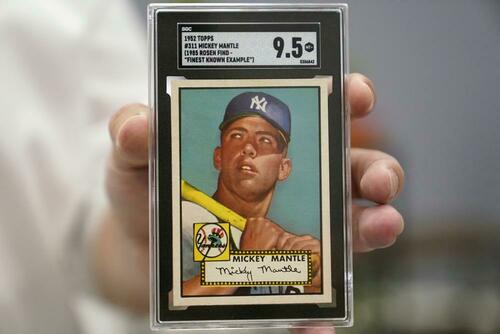
A mint condition Mickey Mantle baseball card sold for $12.6 million Sunday - making it the most expensive piece of sports memorabilia in history.
The 1952 card is widely regarded as one of just a handful of near-perfect cards of the baseball legend. It was bought in 1991 for $50,000 by New Jersey waste management entrepreneur, Anthony Giordano, at a New York City show.
"As soon as it hit 10 million I just turned in. I couldn’t keep my eyes open anymore," said the 75-year-old Giordano on Sunday morning. "They stayed up and called me this morning bright and early to tell me that it reached where it reached."
The card eclipsed the previous record from May, when someone paid $9.3 million for the jersey worn by Diego Maradona when he scored the famous "Hand of God" goal in soccer's 1986 World Cup, according to AP.
Prior to that, someone paid $7.25 million for a 100-year-old Honus Wagner baseball card in a private sale, and another buyer bought Muhammad Ali's heavyweight boxing belt from the 1974 "Rumble in the Jungle" for almost $6.2 million.
As AP notes, "Prices have risen not just for the rarest items, but also for pieces that might have been collecting dust in garages and attics. Many of those items make it onto consumer auction sites like eBay, while others are put up for bidding by auction houses."
Because of its near-perfect condition and its legendary subject, the Mantle card was destined to be a top seller, said Chris Ivy, the director of sports auctions at Heritage Auctions, which ran the bidding.
Some saw collectibles as a hedge against inflation over the past couple years, he said, while others rekindled childhood passions.
Ivy said savvy investors saw inflation coming down the road — as it has. As a result, sports memorabilia became an alternative to traditional Wall Street investments or real estate — particularly among members of Generation X and older millennials. -AP
"There’s only so much Netflix and ‘Tiger King’ people could watch (during the pandemic). So, you know, they were getting back into hobbies, and clearly sports collecting was a part of that," said Ivy, adding that a 'confluence of factors' including interest from wealthy overseas collectors, have made sports collectibles particularly attractive.
"We’ve kind of started seeing some growth and some rise in the prices that led to some media coverage. And I think it all it all just kind of built upon itself," he added. "I would say the beginning of the pandemic really added gasoline to that fire."
Prior to the pandemic, the sports memorabilia market was estimated at just $5.4 billion - according to a 2018 comment by David Yoken, founder of Collectable.com
Just three years later, that market is estimated to be at $26 billion according to research firm Market Decipher, which thinks it will grow to $227 billion within the next decade.
A mint condition Mickey Mantle baseball card sold for $12.6 million Sunday – making it the most expensive piece of sports memorabilia in history.
The 1952 card is widely regarded as one of just a handful of near-perfect cards of the baseball legend. It was bought in 1991 for $50,000 by New Jersey waste management entrepreneur, Anthony Giordano, at a New York City show.
“As soon as it hit 10 million I just turned in. I couldn’t keep my eyes open anymore,” said the 75-year-old Giordano on Sunday morning. “They stayed up and called me this morning bright and early to tell me that it reached where it reached.”
The card eclipsed the previous record from May, when someone paid $9.3 million for the jersey worn by Diego Maradona when he scored the famous “Hand of God” goal in soccer’s 1986 World Cup, according to AP.
[embedded content]
Prior to that, someone paid $7.25 million for a 100-year-old Honus Wagner baseball card in a private sale, and another buyer bought Muhammad Ali’s heavyweight boxing belt from the 1974 “Rumble in the Jungle” for almost $6.2 million.
As AP notes, “Prices have risen not just for the rarest items, but also for pieces that might have been collecting dust in garages and attics. Many of those items make it onto consumer auction sites like eBay, while others are put up for bidding by auction houses.”
Because of its near-perfect condition and its legendary subject, the Mantle card was destined to be a top seller, said Chris Ivy, the director of sports auctions at Heritage Auctions, which ran the bidding.
Some saw collectibles as a hedge against inflation over the past couple years, he said, while others rekindled childhood passions.
Ivy said savvy investors saw inflation coming down the road — as it has. As a result, sports memorabilia became an alternative to traditional Wall Street investments or real estate — particularly among members of Generation X and older millennials. -AP
“There’s only so much Netflix and ‘Tiger King’ people could watch (during the pandemic). So, you know, they were getting back into hobbies, and clearly sports collecting was a part of that,” said Ivy, adding that a ‘confluence of factors’ including interest from wealthy overseas collectors, have made sports collectibles particularly attractive.
“We’ve kind of started seeing some growth and some rise in the prices that led to some media coverage. And I think it all it all just kind of built upon itself,” he added. “I would say the beginning of the pandemic really added gasoline to that fire.”
Prior to the pandemic, the sports memorabilia market was estimated at just $5.4 billion – according to a 2018 comment by David Yoken, founder of Collectable.com
Just three years later, that market is estimated to be at $26 billion according to research firm Market Decipher, which thinks it will grow to $227 billion within the next decade.





